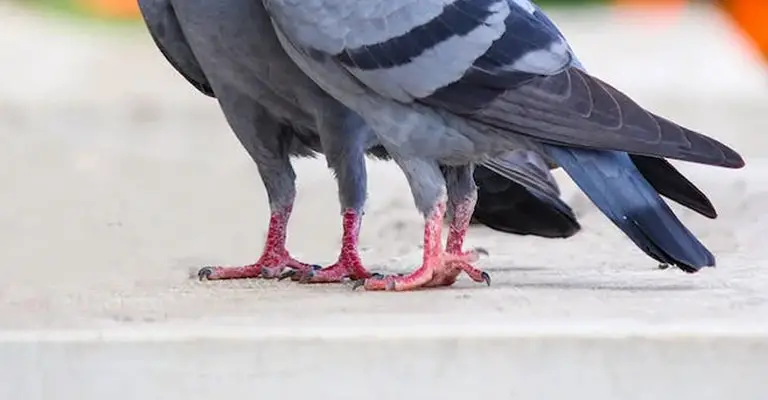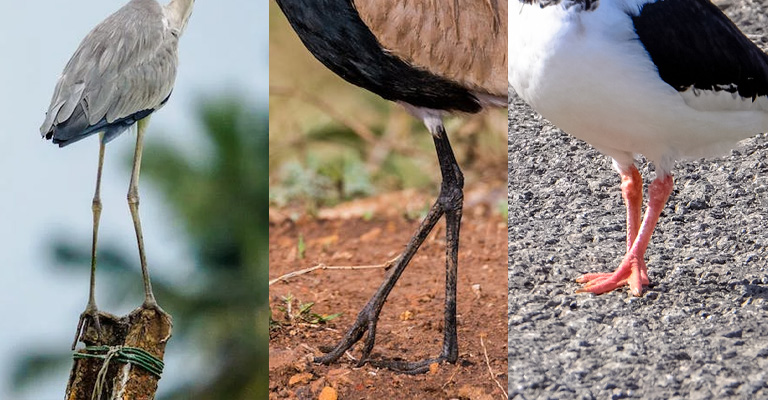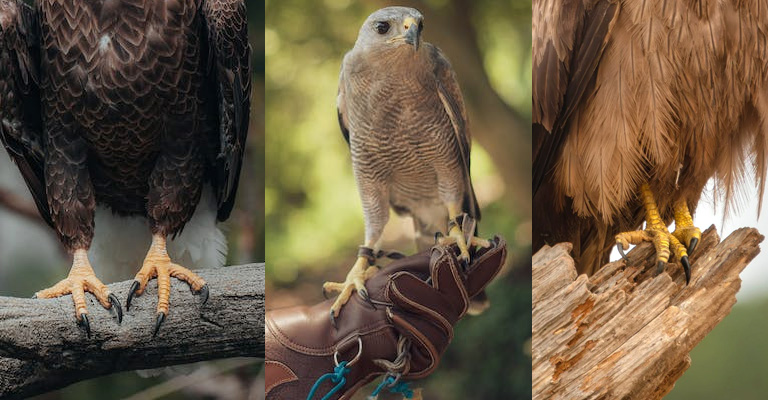Birds possess remarkable adaptations that enable them to thrive in diverse environments. One such adaptation is their unique feet, which play a crucial role in their locomotion, perching, and hunting.
While the terms “foot” and “claws” are often used interchangeably, they refer to distinct aspects of a bird’s anatomy.
Understanding what are the differences between a bird’s foot and its claws can provide insights into their specialized functions and evolutionary adaptations. A bird’s foot encompasses the entire structure, including the bones, muscles, tendons, and skin.
It serves as a multifunctional tool for walking, perching, swimming, and even manipulating objects. On the other hand, a bird’s claws specifically refer to the sharp, curved structures at the end of their toes.
Claws are primarily used for gripping and grasping, aiding in perching, climbing, catching prey, and defending against predators. Read on to learn more details.

What Are the Differences Between a Bird’s Foot and Its Claws?
Birds possess unique adaptations in their feet and claws that allow them to navigate and thrive in their environments.
While the terms “foot” and “claws” are often used interchangeably, they refer to distinct aspects of a bird’s anatomy. Let’s explore the differences between a bird’s foot and its claws in more detail:
Bird’s Foot
- Structure: A bird’s foot encompasses the entire structure, including the bones, muscles, tendons, and skin.
- Functions: The foot serves as a multifunctional tool for walking, perching, swimming, and even manipulating objects.
- Types: There are different types of bird feet, including anisodactyl (three forward-facing toes and one backwards-facing toe), zygodactyl (two forward-facing and two backwards-facing toes), and others, each adapted for specific needs.
Claws
- Structure: Claws are specifically the sharp, curved structures at the end of a bird’s toes.
- Functions: Claws are primarily used for gripping and grasping, aiding in perching, climbing, catching prey, and defending against predators.
- Variations: The size, shape, and curvature of claws can vary among bird species, depending on their ecological niche and feeding habits.
Adaptations
- Talons: Some birds of prey, such as eagles and hawks, have powerful, sharp talons specialized for capturing and gripping prey.
- Hooked Claws: Birds that climb trees, like woodpeckers, possess strong, curved claws that allow them to cling to vertical surfaces.
- Webbed Feet: Water birds, such as ducks and swans, have webbed feet that aid in swimming and propulsion through water.
Structure
- Foot: A bird’s foot consists of multiple parts, including the tarsometatarsus (lower leg bone), metatarsals (long bones of the foot), and phalanges (toe bones). These bones are connected by joints and surrounded by muscles, tendons, and ligaments.
- Claws: Claws are the pointed, keratinized structures at the end of a bird’s toes. They are made of a hard protein called keratin and are attached to the last bone of each toe.
Mobility and Flexibility
- Foot: A bird’s foot is flexible and can be moved and adjusted to adapt to different surfaces and activities. It allows birds to walk, hop, perch, and even manipulate objects.
- Claws: Claws are relatively rigid and less flexible compared to the rest of the foot. They are designed for gripping and holding onto surfaces or prey.
Size and Shape
- Foot: The size and shape of a bird’s foot can vary greatly depending on the species. Some birds have small, delicate feet, while others have large, robust feet adapted for specific purposes, such as wading or grasping prey.
- Claws: Claws also vary in size and shape. They can be long and curved, short and straight, or even specialized into sharp, hooked talons in birds of prey.
Functionality
- Foot: A bird’s foot is essential for various activities, including walking, perching, swimming, and manipulating objects. It provides stability and balance while standing or perching on branches or other surfaces.
- Claws: Claws have specific functions related to gripping, catching prey, and defense. They allow birds to firmly grasp branches, prey items, or surfaces, aiding in their survival and hunting strategies.
Understanding the distinctions between a bird’s foot and its claws provides insights into their specialized functions and evolutionary adaptations.
These adaptations allow birds to perform a wide range of activities, from perching and walking to hunting and surviving in their respective habitats.
Types of Bird Feet

Birds exhibit a fascinating array of foot structures, each adapted to suit their specific needs and lifestyles. Let’s explore some of the different types of bird feet:
Anisodactyl Feet
Anisodactyl feet are the most common type of bird feet. They consist of three forward-facing toes and one backward-facing toe, which is known as the hallux.
This arrangement provides a stable base for perching and walking. Birds with anisodactyl feet include sparrows, finches, and most songbirds.
Zygodactyl Feet
Zygodactyl feet are characterized by two forward-facing toes and two backward-facing toes. This foot structure is well-suited for climbing and grasping branches. Birds with zygodactyl feet include woodpeckers, parrots, and owls.
Palmate Feet
Palmate feet are webbed, with three forward-facing toes partially or fully connected by webbing.
These feet are ideal for birds that spend a significant amount of time in water, such as ducks, geese, and swans. The webbing helps propel them through water with greater efficiency.
Totipalmate Feet
Totipalmate feet are fully webbed, with all four toes connected by webbing. Birds with totipalmate feet, such as pelicans, cormorants, and gannets, are excellent divers and swimmers. The webbing extends all the way to the tip of each toe, aiding in propulsion underwater.
Raptorial Feet
Raptorial feet, also known as talons, are found in birds of prey. They are characterized by sharp, curved claws and strong gripping capabilities.
The toes are typically long and powerful, enabling these birds to catch and hold onto their prey. Eagles, hawks, falcons, and owls possess raptorial feet.
Semipalmate Feet
Semipalmate feet have partial webbing between the toes, with only the basal portions connected. This foot structure is seen in birds that spend time both in water and on land. Examples include sandpipers, plovers, and some gulls.
Types of Bird Claws

Birds possess a wide range of claw structures that are adapted to their specific needs and behaviors. Let’s explore some of the different types of bird claws:
Sharp, Curved Claws
Many birds of prey, such as eagles, hawks, and falcons, have sharp, curved claws known as talons. These powerful claws are designed for capturing and gripping prey securely.
They are typically long and sharp, allowing the birds to maintain a firm grasp on their prey while in flight or perched.
Hooked Claws
Birds that climb trees or cling to vertical surfaces, like woodpeckers and parrots, have hooked claws.
These claws are strong and curved, enabling them to grip onto tree bark or other surfaces with ease. The hooked shape provides stability and support while the birds climb or forage for food.
Flat, Broad Claws
Water birds, such as ducks and geese, have flat, broad claws. These claws are adapted for walking on various surfaces, including land and water.
The broad shape helps distribute the bird’s weight, preventing it from sinking into soft ground or losing balance on slippery surfaces.
Perching Claws
Perching birds, including songbirds and passerines, have specialized claws for gripping and perching on branches.
These claws are relatively small and curved, allowing the birds to tightly grip thin branches or twigs. The curved shape helps maintain balance and stability while resting or sleeping.
Swimming Claws
Some birds that spend a significant amount of time in water, such as grebes and coots, have lobed or scalloped claws.
These specialized claws are adapted for swimming and paddling through water. The lobes or scallops increase the surface area of the claws, providing better propulsion and maneuverability in aquatic environments.
FAQs
The sharp, curved claws of birds of prey, known as talons, are designed for capturing and gripping prey securely. They are long and sharp, allowing the birds to maintain a firm grasp on their prey.
In contrast, the flat, broad claws of water birds are adapted for walking on various surfaces, including land and water.
The hooked claws of climbers, such as woodpeckers, are strong and curved, enabling them to grip onto tree bark or other surfaces with ease.
On the other hand, the perching claws of songbirds are relatively small and curved, allowing them to tightly grip thin branches or twigs.
The swimming claws of water birds, like grebes and coots, often have lobed or scalloped structures. These specialized claws are adapted for swimming and paddling through water.
In contrast, the specialized claws of birds of prey, such as eagles and hawks, are sharp and curved for capturing and gripping prey.
The perching claws of songbirds are relatively small and curved, allowing them to tightly grip thin branches or twigs. The curved shape helps maintain balance and stability while resting or sleeping.
In contrast, the flat, broad claws of water birds are adapted for walking on various surfaces, including land and water.
The sharp, curved claws of birds of prey, known as talons, are designed for capturing and gripping prey securely. They are long and sharp, allowing the birds to maintain a firm grasp on their prey.
The hooked claws of climbers like parrots are strong and curved, enabling them to grip onto tree branches or other surfaces with ease.
Bottom Line
The distinctions between a bird’s foot and its claws highlight the intricate adaptations that enable birds to excel in their environments. Bird’s foot serves as a versatile tool for various activities, while the claws provide specialized gripping and defense capabilities.
By studying these unique features, we can gain a greater understanding of the remarkable diversity and functionality of avian anatomy. Whether it’s the agile perching of a songbird or the powerful talons of a raptor, each bird’s foot and claws are finely tuned for their specific needs.
So, the next time you observe a bird in flight or perched on a branch, take a moment to appreciate the intricate design and functionality of its feet and claws and marvel at the wonders of nature’s adaptations.
By examining the unique characteristics and functions of a bird’s foot and its claws, we can gain a deeper appreciation for these remarkable adaptations.
